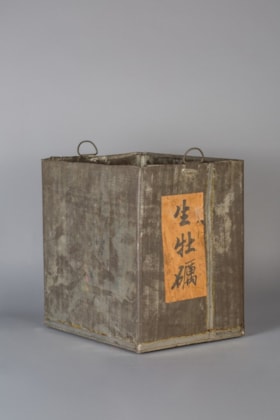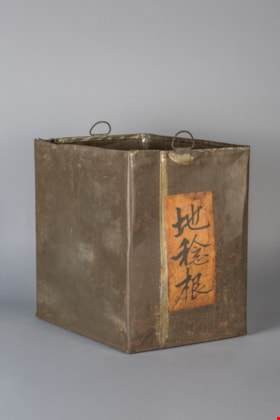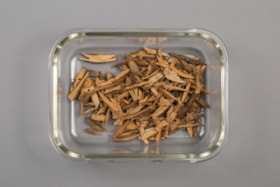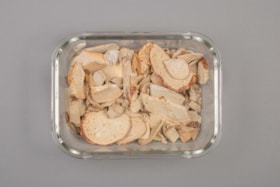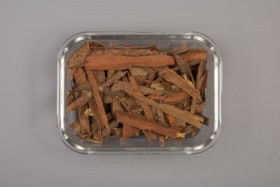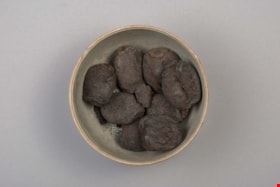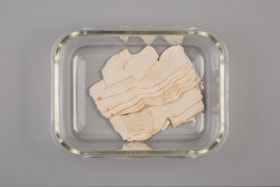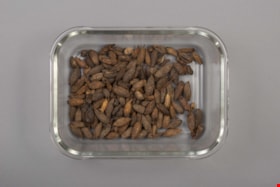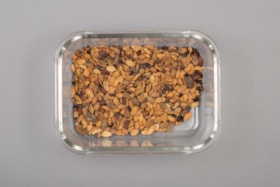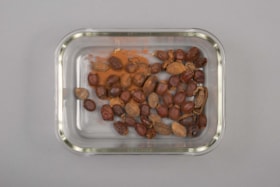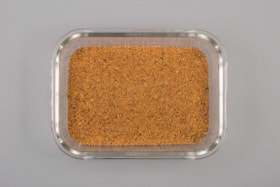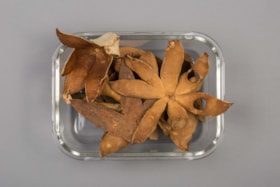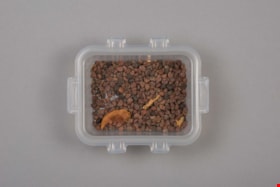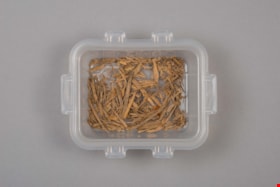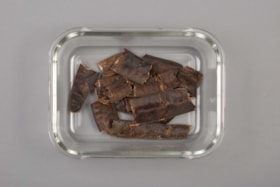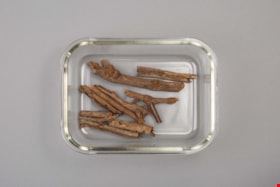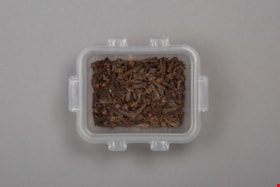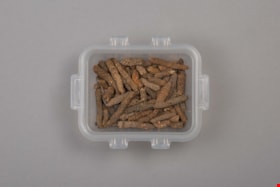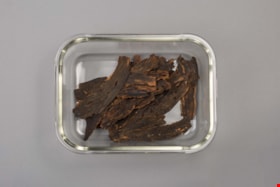Narrow Results By
Subject
- Agriculture 1
- Agriculture - Farms 1
- Agriculture - Ranches 1
- Animals - Pigs 1
- Data Processing Tools and Equipment 1
- Food Processing Tools and Equipment 1
- Food Service Tools and Equipment 4
- Persons - Chinese Canadians 191
- Regulations 1
- Science and Technology Tools and Equipment 192
- Social Issues - Discrimination 1
- Social Issues - Racism 1
A Pig's Tale
https://search.heritageburnaby.ca/link/museumdescription14365
- Repository
- Burnaby Village Museum
- Date
- Oct. 2020
- Collection/Fonds
- Burnaby Village Museum fonds
- Description Level
- Item
- Physical Description
- 3 video recordings (mp4) (5 min., 28 sec.) : digital, col., sd., stereo, subtitles
- Scope and Content
- Item consists of part two in a two part video series "A Taste of History" created by Debbie Liang and Joty Gill, University of British Columbia alumni and graduates from the Asian Canadian & Asian Migration Studies program (ACAM). Part two is titled "A Pig's Tale". The film highlights the history o…
- Repository
- Burnaby Village Museum
- Collection/Fonds
- Burnaby Village Museum fonds
- Series
- UBC Partnership series
- Description Level
- Item
- Physical Description
- 3 video recordings (mp4) (5 min., 28 sec.) : digital, col., sd., stereo, subtitles
- Material Details
- Script: Debbie Liang; Joty Gill Narration: Joty Gill Editor: Debbie Liang Subtitles: English; Simplified Chinese; Traditional Chinese Video Appearances: Kathy Lee; Eleanor Lee Illustrations and Animations: Debbie Liang Photos, Images & B-roll: Piggery photo, image courtesy of Elwin Xie; Douglas Road: City of Burnaby Archives, 477-841; Canada Way, City of Burnaby Archives, 556-522, photo by Peg Campbell; Red pig by Debbie Liang; Piglets sleeping, image courtesy of RoyBuri from pixabay, free to use; Chinese Zodiac, image courtesy of RoofOfAllLight from wikimedia, Creative Commons Attribution-Share Alike 4.0 International license; Pictograph for Home by Debbie Liang; Pigs lying down, image courtesy of Elwin Xie; Council minutes all from heritageburnaby.com; Cleanliness illustration set by Debbie Liang; "The Heathen Chinese in British Columbia" from Library and Archives Canada; Laundryman spitting from Daily News, Prince Rupert in 1911; Slicer on counter at Way Sang Yuen Wat Kee & Co., Burnaby Village Museum BV017.7.290; Way Sang Yuen Wat Kee & Co. Store front, Burnaby Village Museum BV017.7.191; Medical Practices Disagreement illustration by Debbie Liang; Butchering pig, image courtesy of Elwin Xie; Chinatown brolls, courtesy of Food2 group from UBC's 2019 ACAM 390 Class; Black Rotary telephone beside ball pen on white printed paper, image courtesy of Pixabay from pexels.com, free to use; Burnaby Lake on a cloudy day, image courtesy of Flying Pegunin from wikipedia; The Vancouver Sun May 4, 1921 from newspapers.com; Vancouver Daily May 3, 1921 from newspapers.com; Reduce number of pigs illustration by Debbie Liang; Black and white photo of piggery, image courtesy of Elwin Xie; 2019 Piggery illustration by Debbie Liang Music and Sound Effects: "Acoustic Mediation 2" from audionautix; Pig Grunting sounds from Kiddopedia Animasl, Creative Commons 0; "Piano moment" & "November" from bensound.com; "Ding sound effect" from freesoundlibrary; Wuxia2_Guzheng_Pipa by PeriTune http://peritune.com; Music promoted by https://www.free-stock-music.com; Attribution 4.0 International (CC BY 4.0) https://creativecommons.org/licenses/by/4.0/ Video adapted from 2019 BVM intern project by Debbie Liang and Marcela Gomez Special thanks to: UBC: Joanna Yang, Jenny Lu, Denise Fong, Henry Yu; BVM: Kate Petrusa, Amy Wilson Changes to music may have been made for the purposes of this video
- Scope and Content
- Item consists of part two in a two part video series "A Taste of History" created by Debbie Liang and Joty Gill, University of British Columbia alumni and graduates from the Asian Canadian & Asian Migration Studies program (ACAM). Part two is titled "A Pig's Tale". The film highlights the history of Chinese pig farms also known as "Piggeries" in Burnaby. The film tells the story of how many of these farms were established by Chinese immigrants along Douglas Road (now Canada Way) between the 1890s and 1920s; the importance of the pig in the Chinese Culture as well as a way for Chinese immigrants to make a living and the racism and discriminatory bylaws that the Chinese pig farmers suffered that finally led to the closure of many of these farms. Content references three documented piggery ranches along Douglas Road: Ah Sam; Young Chung and Hop Hin Yen. The films are supported with voice over in english, subtitles, animation along with historical photographs. One version of the film is supported with subtitles in English while two other versions of the film are supported with subtitles in Simplified Chinese and Traditional Chinese.
- History
- In 2020, due to the restrictions of COVID-19, University of British Columbia student interns with the Burnaby Village Museum Chinese Canadian History in Burnaby project were asked to create virtual experiences to reimagine Burnaby Village Museum's historical Chinese Canadian programming in remote online spaces. Debbie Liang and Joty Gill (UBC alumni and graduates of Dr. Henry Yu's 2019 summer ACAM 390A Global Seminar to Aisa) returned to work with Burnaby Village Museum to create two short films showcasing the history of Chinese Canadian Chop Suey restaurants and piggeries in Burnaby.
- Creator
- Liang, Debbie
- Debbie Liang
- Subjects
- Persons - Chinese Canadians
- Social Issues - Discrimination
- Social Issues - Racism
- Regulations
- Agriculture
- Agriculture - Farms
- Agriculture - Ranches
- Animals - Pigs
- Names
- Liang, Debbie
- Gill, Joty
- Burnaby Village Museum
- University of British Columbia
- Xie, Elwin
- Way Sang Yuen Wat Kee & Company
- Ah Sam
- Young Chung
- Hop Hin Yen
- Responsibility
- University of British Columbia
- UBC Initiative for Student Teaching and Research in Chinese Canadian Studies
- Burnaby Village Museum
- Geographic Access
- Douglas Road
- Canada Way
- Accession Code
- BV020.28.7
- Access Restriction
- No restrictions
- Reproduction Restriction
- No known restrictions
- Date
- Oct. 2020
- Media Type
- Moving Images
- Historic Neighbourhood
- Burnaby Lake (Historic Neighbourhood)
- Planning Study Area
- Douglas-Gilpin Area
- Notes
- Transcribed title
Images
Video
A Pig's Tale, Oct. 2020
A Pig's Tale, Oct. 2020
https://search.heritageburnaby.ca/media/hpo/_Data/_BVM_Moving_Images/2020_0028_0007_001.mp4bin
https://search.heritageburnaby.ca/link/museumartifact24711
- Repository
- Burnaby Village Museum
- Accession Code
- HV975.5.1208
- Description
- Tin, has Chinese characters on it
- Object History
- This item originates from the Chinese Herbalist Store "Way Sang Yuen Wat Kee & Co.", Victoria B.C.
- Classification
- Chemical T&E
- Measurements
- 25cm height x 17cm width x 15cm depth
Images
bin
https://search.heritageburnaby.ca/link/museumartifact24713
- Repository
- Burnaby Village Museum
- Accession Code
- HV975.5.1210
- Description
- Rectangular metal container with two small D shaped handles welded on opposite sides of the rim. Orange paper label has three handwritten Chinese characters.
- Object History
- This item originates from the Chinese Herbalist Store "Way Sang Yuen Wat Kee & Co.", Victoria B.C.
- Classification
- Chemical T&E
- Marks/Labels
- Chinese characters on label, which literally translate to mean "ground" "ripe grain" "root". When adjusted for English translation, "Root of Twelve stamen Melastoma Dodecandrum Lour". Uses in Chinese medicine: Bitter, slightly sweet, neutral. For liver, spleen and lung meridians. Action: Promote blood circulation, stop bleeding, eliminate dampness and remove toxicity. Indications: Scrofula, toothache, dysentery, leucorrhea, uterine bleeding, abdominal pain after delivery, dysmenorrhea."
- Measurements
- 25cm height x 17cm width x 15cm depth
Images
botanical specimen
https://search.heritageburnaby.ca/link/museumartifact88633
- Repository
- Burnaby Village Museum
- Accession Code
- BV017.7.5
- Description
- English Name: Lightyellow Sophora Root Chinese Pinyin Name: Kushen (KuShen) Physical Description: small cut or chipped pieces of root, pale brown, with bark still attached Production Regions: Primarily produced in the Chinese provinces of Henan, Hebei, Shanxi,etc. Functions: Clears heat, dries dampness, dispels wind, kills worms. Apply to diarrhea due to damp heat, hematochezia due to intestine wind, jaundice, dysuria, edema, vaginal discharge, vaginal itch, abscess and tinea, lepra, skin itch, sore with damp toxin
- Object History
- Collection of original raw contents of the Chinese Herbalist Shop, Way Sang Yuen Wat Kee, Victoria BC, as purchased from Rodney Pain in 1974.
- Reference
- Hong Kong Chinese Materia Medica Standards Volume 4. Retrived on 25 July 2017. URL: http://www.cmd.gov.hk/doc/search/Sophorae_Flavescentis_Radix_v4_e.pdf Chinese Medicinal Material Images Database, School of Chinese Medicine, Hong Kong Baptist University. URL: http://libproject.hkbu.edu.hk/was40/detail?channelid=47953&lang=eng&searchword=pid=B00018 Compendium of Materia Medica (Bencao Gangmu), 2003; Taiwan Herbal Pharmacopeia, 2014.
Images
botanical specimen
https://search.heritageburnaby.ca/link/museumartifact88638
- Repository
- Burnaby Village Museum
- Accession Code
- BV017.7.10
- Description
- unidentified
- Object History
- Collection of original raw contents of the Chinese Herbalist Shop, Way Sang Yuen Wat Kee, Victoria BC, as purchased from Rodney Pain in 1974.
Images
botanical specimen
https://search.heritageburnaby.ca/link/museumartifact88639
- Repository
- Burnaby Village Museum
- Accession Code
- BV017.7.11
- Description
- Cassia bark or Rougui, also known as Cinnamomi Cortex.
- Object History
- Collection of original raw contents of the Chinese Herbalist Shop, Way Sang Yuen Wat Kee, Victoria BC, as purchased from Rodney Pain in 1974.
- Used to warm spleen and stomach, elminates cold accumulation, frees blood and veins.
Images
botanical specimen
https://search.heritageburnaby.ca/link/museumartifact88645
- Repository
- Burnaby Village Museum
- Accession Code
- BV017.7.17
- Description
- Radix Rehmanniae
- Object History
- Collection of original raw contents of the Chinese Herbalist Shop, Way Sang Yuen Wat Kee, Victoria BC, as purchased from Rodney Pain in 1974.
Images
botanical specimen
https://search.heritageburnaby.ca/link/museumartifact88647
- Repository
- Burnaby Village Museum
- Accession Code
- BV017.7.19
- Description
- English Name: Snakegourd Root Chinese Pinyin Name: Tianhuafen (TianHuaFen) Physical Description: thin longitudinal slices of dried root, white; slightly irregular rectangular shapes with horizontal rippling; surfaces are dotted in places; some pieces broken Production Regions: Primarily produced in the Chinese provinces of Hebei, Shandong, Shaanxi, Shanxi. Functions: Clears heat, drains fire, engenders fluid, stops thirst, expels pus, eliminates swelling. Apply to thirst due to heat, diabetes, jaundice, hemoptysis due to dryness of lung, swelling abscess, hemorrhoid fistula. As for apply to diabetes, often combined with medicinal material, which can nourish yin, to achieve the effect.
- Object History
- Collection of original raw contents of the Chinese Herbalist Shop, Way Sang Yuen Wat Kee, Victoria BC, as purchased from Rodney Pain in 1974.
- Reference
- Chinese Medicinal Material Images Database, School of Chinese Medicine, Hong Kong Baptist University. URL: http://libproject.hkbu.edu.hk/was40/detail?channelid=47953&lang=eng&searchword=pid=B00104
Images
botanical specimen
https://search.heritageburnaby.ca/link/museumartifact88658
- Repository
- Burnaby Village Museum
- Accession Code
- BV017.7.30
- Description
- litchi seed (Litchi Chinensis); used to relieve pain in colic, gastralgia, and orchitis
- Object History
- Collection of original raw contents of the Chinese Herbalist Shop, Way Sang Yuen Wat Kee, Victoria BC, as purchased from Rodney Pain in 1974.
- Reference
- Keys, John D. "Chinese Herbs". Rutland: Charles E Tuttle Company, Inc., 1976.
Images
botanical specimen
https://search.heritageburnaby.ca/link/museumartifact88659
- Repository
- Burnaby Village Museum
- Accession Code
- BV017.7.31
- Description
- Seed of Chinese Wampee
- Object History
- Collection of original raw contents of the Chinese Herbalist Shop, Way Sang Yuen Wat Kee, Victoria BC, as purchased from Rodney Pain in 1974.
Images
botanical specimen
https://search.heritageburnaby.ca/link/museumartifact88660
- Repository
- Burnaby Village Museum
- Accession Code
- BV017.7.32
- Description
- English Name: Villous Amomun Fruit Chinese Pinyin Name: Sharen (ShaRen / SuoShaMiRen) Physical Description: many small dried fruits, flattened ovals, ranging from pale tan to darker reddish brown colour; some have longitudinal ridges, others appear wrinkled, with stem protrusion one end or hole; at least one is broken open Production Regions: Primarily produced in the Chinese provinces of Guangdong, Guangxi. Imported sha ren is produced in Vietnam, Thailand, Myanmar, and Indonesia. Functions: Transforms dampness, increases appetite, warms spleen, relieves diarrhea, regulates qi, calms fetus. Apply to retention of dampness in the middle, abdominal fullness and anorexia, deficiency and cold spleen and stomach, vomit and diarrhea, pernicious vomiting, restless fetal movements.
- Object History
- Collection of original raw contents of the Chinese Herbalist Shop, Way Sang Yuen Wat Kee, Victoria BC, as purchased from Rodney Pain in 1974.
- Reference
- Chinese Medicinal Material Images Database, School of Chinese Medicine, Hong Kong Baptist University. URL: http://libproject.hkbu.edu.hk/was40/detail?channelid=47953&lang=eng&searchword=pid=B00254 ; Compendium of Materia Medica (Bencao Gangmu), 2003;
Images
botanical specimen
https://search.heritageburnaby.ca/link/museumartifact88666
- Repository
- Burnaby Village Museum
- Accession Code
- BV017.7.38
- Description
- mustard seed; used internally to discharge mucus
- Object History
- Collection of original raw contents of the Chinese Herbalist Shop, Way Sang Yuen Wat Kee, Victoria BC, as purchased from Rodney Pain in 1974.
- Reference
- Keys, John D. "Chinese Herbs". Rutland: Charles E Tuttle Company, Inc., 1976.
Images
botanical specimen
https://search.heritageburnaby.ca/link/museumartifact88669
- Repository
- Burnaby Village Museum
- Accession Code
- BV017.7.41
- Description
- mandarin orange peel (Citrus Nobilis); used to sooth the stomach, to aid digestion, to discharge mucus
- Object History
- Collection of original raw contents of the Chinese Herbalist Shop, Way Sang Yuen Wat Kee, Victoria BC, as purchased from Rodney Pain in 1974. Orange Peel is used as a traditional seasoning in Chinese cooking and in traditional medicine. Today, orange peel essential oil is a common beauty product used around the world.
- Reference
- Keys, John D. "Chinese Herbs". Rutland: Charles E Tuttle Company, Inc., 1976.
Images
botanical specimen
https://search.heritageburnaby.ca/link/museumartifact88671
- Repository
- Burnaby Village Museum
- Accession Code
- BV017.7.43
- Description
- English Name: Pharbitis Seed / Lobedleaf Pharbitis Seed Chinese Pinyin Name: Qianniuzi (QianNiuZi) Physical Description: many small dried seeds, colours vary from light tan to dark brown; wedge-shaped with curved backs, like orange segments; backs have single groove Production Regions: Primarily produced in the Chinese provinces of Guangxi, Yunnan. Functions: Drains water, frees stools, eliminates phlegm, clears fluid, kills worms, attacks stagnation. Apply to edema and fullness, fecal and urinary stoppage, inverse qi and panting, worm stagnation and abdominal pain, ascariasis, taeniasis.
- Object History
- Collection of original raw contents of the Chinese Herbalist Shop, Way Sang Yuen Wat Kee, Victoria BC, as purchased from Rodney Pain in 1974.
- Reference
- Chinese Medicinal Material Images Database, School of Chinese Medicine, Hong Kong Baptist University. URL: http://libproject.hkbu.edu.hk/was40/detail?channelid=47953&lang=eng&searchword=pid=B00198 Compendium of Materia Medica (Bencao Gangmu), 2003; Taiwan Herbal Pharmacopeia, 2014.
Images
botanical specimen
https://search.heritageburnaby.ca/link/museumartifact88673
- Repository
- Burnaby Village Museum
- Accession Code
- BV017.7.45
- Description
- English Name: Chinese Eaglewood / Tambac Chinese Pinyin Name: Chenxiang (ChenXiang) Physical Description: wood fragments, small, light to medium brown; thin shavings or splinters in varying sizes Production Regions: Primarily produced in the Chinese provinces of Guangdong, Hainan, Guangxi, Fujian, Taiwan. Functions: Moves qi and relieves pain, warms the center and stops vomiting, promotes qi absorption and calms panting. Apply to chest and abdominal swelling pain, gastric cold and vomiting and hiccoughs, deficiency of kidney and inability to breathe due to adverse rising of qi.
- Object History
- Collection of original raw contents of the Chinese Herbalist Shop, Way Sang Yuen Wat Kee, Victoria BC, as purchased from Rodney Pain in 1974.
- Reference
- Chinese Medicinal Material Images Database, School of Chinese Medicine, Hong Kong Baptist University. URL: http://libproject.hkbu.edu.hk/was40/detail?channelid=47953&lang=eng&searchword=pid=B00421 Compendium of Materia Medica (Bencao Gangmu), 2003; Taiwan Herbal Pharmacopeia, 2014.
Images
botanical specimen
https://search.heritageburnaby.ca/link/museumartifact88674
- Repository
- Burnaby Village Museum
- Accession Code
- BV017.7.46
- Description
- English Name: Chinese Honeylocust Abnormal Fruit / Abnorma Chinese Honeylocust Fruit Chinese Pinyin Name: Zhuyazao (ZhuYaZao) Physical Description: dried fruit, large flat rectangular pieces torn from larger pods, dark brown with lighter brown areas; some pieces are curved along one side; leathery surfaces with creases and tears, and fraying along torn edges Production Regions: Primarily produced in the Chinese provinces of Shandong, Yunnan, Guizhou, Sichuan. Functions: Opens orifices, transforms phlegm, dispels wind, kills worms. Apply to apoplexy and lockjaw, head wind, inveterate wind evil, throat impediment, panting with phlegm, distention and fullness accumulation, blocking orifices, swelling abscess, ulcer, tinea, head sore
- Object History
- Collection of original raw contents of the Chinese Herbalist Shop, Way Sang Yuen Wat Kee, Victoria BC, as purchased from Rodney Pain in 1974.
- Reference
- Chinese Medicinal Material Images Database, School of Chinese Medicine, Hong Kong Baptist University. URL: http://libproject.hkbu.edu.hk/was40/detail?channelid=47953&lang=eng&searchword=pid=B00225; Compendium of Materia Medica (Bencao Gangmu), 2003; Taiwan Herbal Pharmacopeia, 2014.
Images
botanical specimen
https://search.heritageburnaby.ca/link/museumartifact88675
- Repository
- Burnaby Village Museum
- Accession Code
- BV017.7.47
- Description
- English Name: Cassia bark tree Twig Chinese Pinyin Name: Guizhi (GuiZhi) Physical Description: twigs, short, light brown, varying thicknesses, with some ridging and wrinkling along their lengths; some have short pieces branching off, some show a scar where a branching piece has broken off; some are cut or broken to blunt ends, others have bark missing at end, some have protruding bark ends with no wood inside Production Regions: Primarily produced in the Chinese provinces of Fujian, Guangdong, Guangxi. Functions: Promotes sweating, resolves the flesh, warms and frees the channels and vessels, assists yang in transforming qi, downbears qi. Apply to wind-cold type of common cold, abdominal cold pain, amenorrhea due to cold blood, joint impediment, phlegm and retained fluid, edema, palpitations, renal mass.
- Object History
- Collection of original raw contents of the Chinese Herbalist Shop, Way Sang Yuen Wat Kee, Victoria BC, as purchased from Rodney Pain in 1974. Cassia bark twig is also known as Chinese cinnamon and has been used in Chinese medicine for centuries. Most of the cinnamon sold in Canada’s supermarkets is Chinese cinnamon.
- Reference
- Chinese Medicinal Material Images Database, School of Chinese Medicine, Hong Kong Baptist University. URL: http://libproject.hkbu.edu.hk/was40/detail?channelid=47953&lang=eng&searchword=pid=B00138 Compendium of Materia Medica (Bencao Gangmu), 2003; Taiwan Herbal Pharmacopeia, 2014.
Images
botanical specimen
https://search.heritageburnaby.ca/link/museumartifact88680
- Repository
- Burnaby Village Museum
- Accession Code
- BV017.7.52
- Description
- English Name: Clove Chinese Pinyin Name: Dingxiang (DingXiang) Physical Description: small dried flower buds, dark brown and twiglike with rounded heads held by 4 sepals; lower portions are slightly tapered and rough Production Regions: Primarily produced in Zanzibar Island of Tanzania, as well as Malaysia and Indonesia. In China, it has been introduced into cultivation in the provinces of Hainan and Guangdong. Functions: Warms stomach, warms kidney. Apply to cold stomach and swelling pain, hiccup, vomiting and diarrhea, impediment, colic, ozostomia, toothache.
- Object History
- Collection of original raw contents of the Chinese Herbalist Shop, Way Sang Yuen Wat Kee, Victoria BC, as purchased from Rodney Pain in 1974.
- Reference
- Chinese Medicinal Material Images Database, School of Chinese Medicine, Hong Kong Baptist University. URL: http://libproject.hkbu.edu.hk/was40/detail?channelid=47953&lang=eng&searchword=pid=B00299 ; Compendium of Materia Medica (Bencao Gangmu), 2003;
Images
botanical specimen
https://search.heritageburnaby.ca/link/museumartifact88681
- Repository
- Burnaby Village Museum
- Accession Code
- BV017.7.53
- Description
- English Name: Long Pepper Fruit
- Chinese Pinyin Name: Bibo (Bibo)
- Physical Description: small medium-brown cylindrical fruit spikes of similar length and thickness, slight curve visible in some; small protuberances evenly distributed along pieces
- Production Regions: Primarily produced in Indonesia.
- Functions: Warms the center, disperses cold, downbears qi, relieves pain. Apply to cold pain of gastric cavity and abdomen, vomiting, diarrhea, nasosinusitis, hemicrania, externally used for toothache, coronary disease, angina pectoris; heart and abdominal cold pain, vomiting and sour regurgitation, diarrhea with intestine rumbling, cold diarrhea, yin hernia, headache, toothache.
- Object History
- Collection of original raw contents of the Chinese Herbalist Shop, Way Sang Yuen Wat Kee, Victoria BC, as purchased from Rodney Pain in 1974.
- Reference
- Chinese Medicinal Material Images Database, School of Chinese Medicine, Hong Kong Baptist University. URL: http://libproject.hkbu.edu.hk/was40/detail?channelid=47953&lang=eng&searchword=pid=B00156
Images
botanical specimen
https://search.heritageburnaby.ca/link/museumartifact88683
- Repository
- Burnaby Village Museum
- Accession Code
- BV017.7.55
- Description
- English Name: Lobed Kudzuvine Root Chinese Pinyin Name: Gegen (GeGen) Physical Description: roots, dried, flat, rough dark brown surfaces with longitudinal wrinkles; mostly rectangular but tapered in places Production Regions: Primarily produced in the Chinese provinces of Henan, Zhejiang, Guangdong, Hunan. Functions: Resolves exterior, abates heat, engenders fluid, outthrusts measles, raise yang, relieves diarrhea. Apply to fever and headache caused by exogenous pathogens, stiffness of the neck due to hypertension, hydrodipsia, diabetes, measles without adequate eruptions, dysentery of heat type, diarrhea.
- Object History
- Collection of original raw contents of the Chinese Herbalist Shop, Way Sang Yuen Wat Kee, Victoria BC, as purchased from Rodney Pain in 1974.
- Reference
- Chinese Medicinal Material Images Database, School of Chinese Medicine, Hong Kong Baptist University. URL: http://libproject.hkbu.edu.hk/was40/detail?channelid=47953&lang=eng&searchword=pid=B00063 Compendium of Materia Medica (Bencao Gangmu), 2003; Taiwan Herbal Pharmacopeia, 2014.



